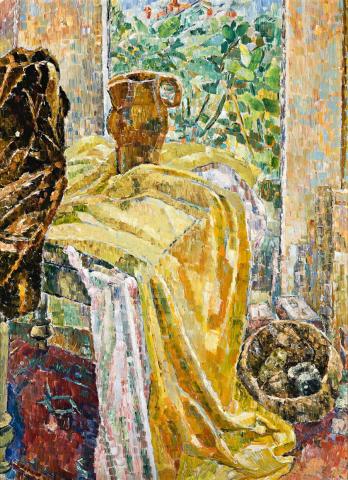YELLOW DRAPES, 1954
GRACE COSSINGTON SMITH
oil on composition board
76.0 x 54.5 cm
signed and dated lower left: G Cossington Smith 54
Adrian Feint, Sydney, cat. F 11
Artarmon Galleries (Artlovers), Sydney (label attached verso)
Private collection, Melbourne, acquired from the above in 1979
Paintings once owned by other artists are special. And a still life once in the collection of another master of this genre, Adrian Feint, is more so. This invites double pleasure in the discovery of what makes Grace Cossington Smith's Yellow Drapes, 1954 so special. It is a typical work, an interior with the common oddments of still life, rather similar to Still Life with Boronia, 1955, once in the collection of The Lady Casey and sold by Deutscher and Hackett in April last year.1 Significantly, The Lady Casey was also an artist and fine connoisseur of art. The scenes in both are within Cossington Smith's home at Turramurra, the everyday of flowers, fruit, a view to the garden beyond, and the shared flow of yellow drapery. But they transcend the mere domestic moment, transformed into golden works of art through the artist's use of light suffused with colour. Light and colour, here no commonplace, invite and invoke the viewer to join the artist in her enjoyment of the visual world and the exploration of that which lies beyond in its beauty through wonderment. 'My chief interest, [Cossington Smith said], ... has always been colour, but not the flat crude colour, it must be colour within colour, it has to shine; light must be in it ...'2 For her, the light of the physical world is also the light of enlightenment; and it sparkles throughout her paintings.
As this painting shows, yellow is a favourite. Cascading in abundance, as in Yellow Drapes, it touches, as the sun, and gives all things life. She called yellow 'the colour of the sun', and let it flood into her picture through the open door - uniting exterior with the interior, harmonizing the commonplace with the metaphorical.3 Through the individuality of their application, the brush strokes vibrate, giving added life to the picture surface and greater depth to its meaning. Yet, all this vitality is permeated with a peace and tranquillity, of grace and elegance, old fashioned ideas never before more needed in our contemporary world.
Commenting on her art in 1969 for Mervyn Horton's book, Present Day Art in Australia, Cossington Smith summed up her art exactly.'All form - landscape, interiors, still life, flowers, animals, people - have an articulate grace and beauty; painting to me is expressing this form in colour, colour vibrant with light - but containing this other, silent quality which is unconscious, and belongs to all things created.'4 Yellow Drapes does this superbly.
1. Melbourne, 24 April 2013, lot 6
2. The artist in conversation with Hazel de Berg, 16 August 1965, National Library of Australia, Canberra, quoted in Modjeska, D., Stravinsky's Lunch, Picador, Pan Macmillan Australia, Sydney, 1999, p. 227
3. ibid., p. 225
4. 'Artist's Comment', in Horton, M., (ed), Present Day Art in Australia, Ure Smith, Sydney, 1969, p. 203
DAVID THOMAS
